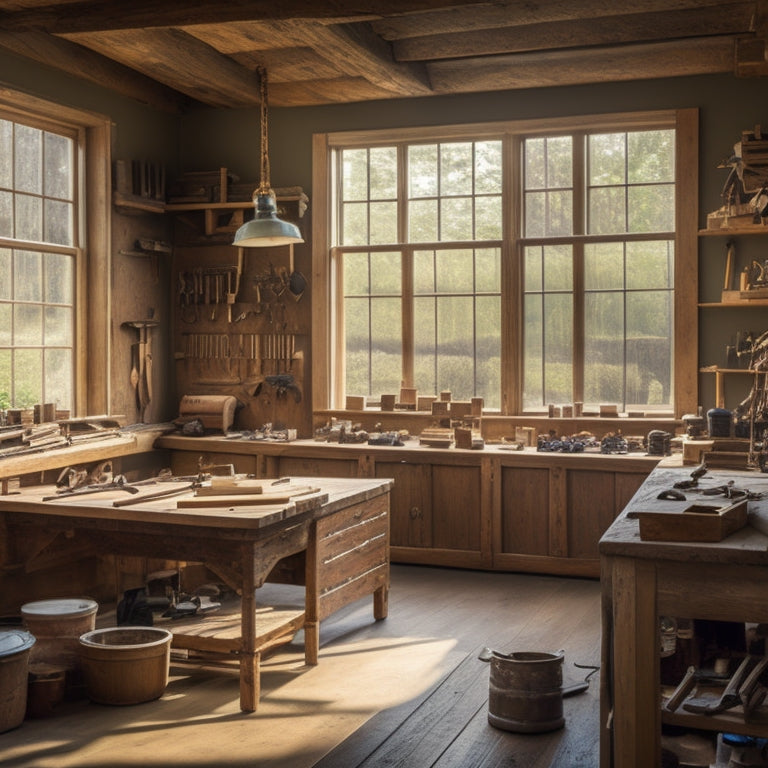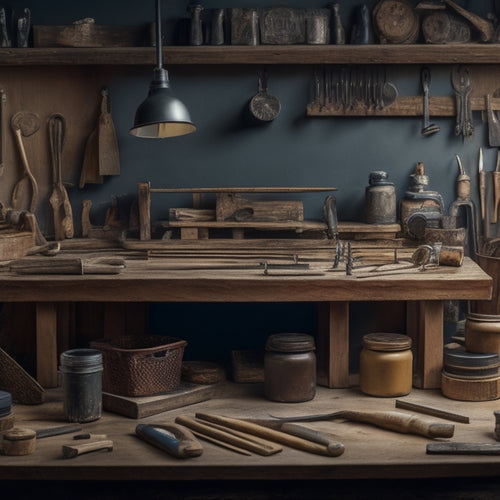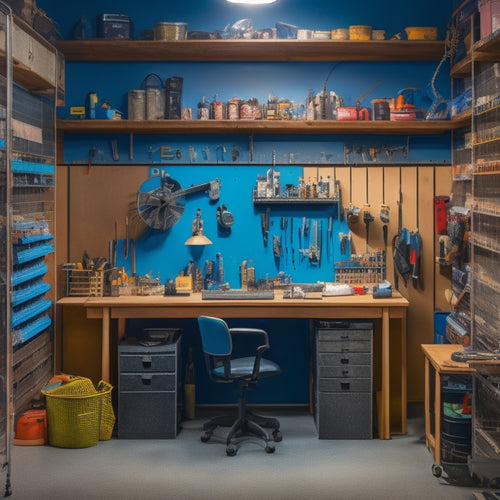
Boost Woodworking Efficiency With These Pro Tips
Share
To boost woodworking efficiency, you'll want to start by optimizing your workshop layout, allocating space for each stage of the process to reduce walking distances and improve space utilization. Next, streamline your measurement process with digital calipers and laser measurement technology for precise markings. Master efficient cutting techniques by adjusting blade angles and minimizing waste generation. Implement space-saving storage solutions and prioritize scrap wood utilization to reduce waste and promote sustainability. By implementing these pro tips, you'll be well on your way to slashing mistakes, waste, and frustration - and revealing your full woodworking potential awaits.
Key Takeaways
• Optimize your workshop layout to reduce walking distances, improve space utilization, and prioritize ergonomics for comfort and safety.
• Streamline your measurement process with digital calipers, marking gauges, and laser measurement technology for accurate and efficient results.
• Implement efficient cutting techniques by adjusting blade angles, minimizing waste, and promoting green woodworking practices for a sustainable future.
• Maximize storage and organization with space-saving solutions, labeling systems, and creative storage ideas to maintain control and quick tool/material identification.
• Repurpose scrap wood into useful items, reducing waste, promoting sustainability, and saving money on materials for future projects.
Essential Tools for Woodworking Success
You'll need a solid arsenal of essential tools to streamline your woodworking process and guarantee success in your projects. A well-stocked workshop is important, but it's equally important to confirm your tools are in top condition.
Regular tool maintenance is essential to prevent wear and tear, which can lead to inaccurate cuts and compromised safety. Set aside time to clean, sharpen, and lubricate your tools to maintain their performance.
Safety precautions are also crucial in woodworking. Always wear protective gear, such as safety glasses, ear protection, and a dust mask, to prevent injuries from flying debris, loud machinery, and airborne particles. Keep your workshop well-ventilated and confirm good lighting to reduce eye strain and improve visibility.
Additionally, keep loose clothing and long hair tied back, and avoid wearing jewelry that could get caught in machines. By prioritizing tool maintenance and safety precautions, you'll be able to work efficiently and effectively, producing high-quality results while minimizing the risk of accidents.
Optimizing Your Workshop Layout
With your tools in top condition and safety protocols in place, organize your workshop layout to maximize productivity by allocating space for each stage of your woodworking process. A well-planned layout boosts workflow efficiency, reduces fatigue, and minimizes the risk of accidents.
To optimize your workshop layout, consider the following key areas:
| Zone | Equipment | Purpose |
|---|---|---|
| Rough Cut | Table saw, miter saw | Break down lumber into manageable pieces |
| Assembly | Workbench, clamps | Assemble components into final products |
| Finishing | Sanding station, finishing tools | Add final touches and coatings to projects |
Strategically place equipment to reduce walking distances and improve space utilization. Ergonomics optimization is also essential; position tools to reduce strain on your body and promote comfortable working postures. By allocating space for each stage of your process, you'll be able to work more efficiently, complete projects faster, and enjoy a safer, more satisfying woodworking experience.
Streamlining Your Measurement Process
Accurate measurements are vital for successful woodworking projects, and optimizing your measurement process saves time and reduces errors. You can achieve this by investing in digital calipers, which provide precise measurements with minimal effort.
Additionally, a marking gauge helps you make consistent and precise markings on your wood. This eliminates the need for repeated measurements, saving you time and reducing the risk of errors.
To elevate your measurement process, consider incorporating laser measurement technology. This allows you to quickly and precisely measure large or intricate pieces, eliminating the need for manual measurements.
When paired with precision marking tools, you can guarantee that your markings are precise and consistent, even on curved or irregular surfaces. By streamlining your measurement process, you'll be able to focus on the creative aspects of woodworking, rather than getting bogged down in tedious measurements.
With the right tools and techniques, you'll be able to work more efficiently and produce high-quality results.
Mastering Efficient Cutting Techniques
When you're cutting wood, every degree and every inch counts.
You're about to learn how to optimize your blade angle to make the most precise cuts while minimizing waste generation.
Optimize Blade Angle
You can greatly improve your cutting efficiency by adjusting the blade angle to suit the specific cutting task at hand. This simple yet pivotal step can make a significant difference in your woodworking projects. By optimizing the blade angle, you can reduce wear and tear on your blades, improve precision cutting techniques, and ultimately boost your overall productivity.
Here's a quick reference guide to help you get started:
| Material | Blade Angle | Benefits |
|---|---|---|
| Softwoods | 20-25° | Reduced kickback, smoother cuts |
| Hardwoods | 25-30° | Increased precision, reduced wear |
| Plywood/MDF | 15-20° | Reduced tear-out, improved finish |
Minimize Waste Generation
By mastering efficient cutting techniques, you'll not only optimize your blade angle but also minimize waste generation, reducing the environmental impact and saving you time and resources in the process. To achieve this, focus on making precise cuts, using the right tools, and planning your project carefully. This will help you reduce scraps and leftovers, which can be recycled or repurposed, promoting material recycling and waste reduction.
Incorporating green woodworking practices into your workflow can also have significant sustainability benefits. By adopting a zero-waste approach, you'll reduce your carbon footprint, conserve natural resources, and create a more eco-friendly workshop.
To take it a step further, consider implementing a recycling program for your wood waste, allowing you to reuse or repurpose materials that would otherwise end up in landfills. By adopting these practices, you'll not only boost your woodworking efficiency but also contribute to a more sustainable future.
Maximizing Storage and Organization
Ideally arranged workshops prioritize storage and organization, freeing up valuable floor space and slashing downtime spent searching for misplaced tools and materials. You can achieve this by implementing space-saving solutions and creative storage ideas that cater to your specific needs.
For instance, consider installing wall-mounted cabinets, shelves, or pegboards to keep frequently used tools within easy reach.
Use stackable containers and bins to store small parts, screws, and other hardware, keeping them organized and easily accessible.
Designate a specific area for your most-used tools, ensuring they're always within arm's reach, and label each station for quick identification.
Implement a labeling system for your tools and materials, allowing you to quickly locate what you need and maintain a sense of control over your workshop.
Reducing Waste and Errors
When you're working on a woodworking project, minimizing waste and errors is essential to saving time and resources.
By implementing a few simple strategies, you can greatly reduce the amount of scrap wood and rework required.
To get started, you'll want to focus on cutting accurate measurements first, using scrap wood wisely, and planning your project layout carefully.
Cut Accurate Measurements First
To guarantee precise cuts and minimize errors, you must start by taking accurate measurements. Small mistakes can quickly accumulate and result in wasted materials and time. Inaccurate measurements can lead to faulty joints, uneven edges, and a finished product that falls short of your vision.
To avoid these common pitfalls, follow these best practices:
-
Verify your measurements: Double-check your calculations and measurements to ensure precision before making a single cut.
-
Use high-quality tools: Regular tool maintenance is essential for precision cutting. Keep your blades sharp and your saws calibrated to guarantee accurate cuts.
-
Plan your project carefully: Choose the right materials for the job and plan your project from start to finish. This will help you identify potential errors and make adjustments before they become costly mistakes.
Use Scrap Wood Wisely
You can greatly reduce waste and errors by treating scrap wood as a valuable resource, rather than simply discarding it. By doing so, you'll adopt an essential aspect of sustainability practices in your woodworking process.
Instead of throwing away scraps, set them aside for future creative projects. You might be surprised at how often you can repurpose them into useful items, such as small tool holders, coasters, or even decorative accents. This mindset shift won't only reduce waste but also help you develop your problem-solving skills.
When working on a project, try to identify opportunities to use scrap wood for smaller components, like drawer dividers or shelf supports. By incorporating scrap wood into your workflow, you'll minimize errors caused by incorrect measurements or faulty cuts. Additionally, you'll reduce the amount of new wood needed for future projects, making your woodworking practice more environmentally friendly.
Plan Project Layout Carefully
By carefully planning your project layout, you'll identify opportunities to optimize material usage, minimize waste, and reduce errors, ultimately saving time and resources. This critical step allows you to visualize your project's progression, ensuring that every cut, joint, and assembly is executed with precision.
When planning your project layout, consider the following key factors:
-
Material selection: Choose materials that not only meet your design requirements but also minimize waste. Consider using reclaimed or sustainably sourced woods to reduce your environmental footprint.
-
Design flexibility: Leave room for adjustments and modifications as needed. A flexible design allows you to adapt to changes in your project timeline or material availability.
-
Tool maintenance: Schedule regular tool maintenance to prevent equipment failures, which can lead to costly delays and errors.
Frequently Asked Questions
How Do I Prevent Wood From Warping During the Drying Process?
To prevent wood from warping during drying, you'll want to guarantee proper moisture control, utilizing kiln drying or air drying with strategic stacking and ventilation techniques to minimize warping and maximize stability.
Can I Use a Circular Saw for Fine Woodworking Projects?
You'll find fascinating flexibility with a circular saw, but for fine woodworking projects, its accuracy is limited; instead, opt for a table saw or router for precise cuts, especially when crafting intricate plywood furniture.
What Safety Gear Is Essential for Woodworking Beginners?
When you start woodworking, you'll need essential safety gear like safety glasses, ear protection, and a dust mask to protect yourself from debris and noise while mastering various woodworking techniques and safety precautions.
How Do I Remove Old Finishes From Reclaimed Wood?
"A million hours of sanding await if you don't remove old finishes correctly! You'll want to explore eco-friendly alternatives like citrus-based strippers or opt for chemical stripping techniques, ensuring a smooth surface for your reclaimed wood masterpiece."
Can I Use Plywood for Building Fine Furniture Pieces?
You can use plywood for building fine furniture pieces, but weigh the pros and cons: stability and cost-effectiveness versus potential delamination and aesthetic limitations. Consider alternative materials, like solid wood or MDF, for a more premium look.
Related Posts
-

Small Storage Bins to Maximize Shelf Space
When maximizing shelf space, you want to make the most of every inch. Small storage bins are the answer, but choosing...
-

Top 5 Small Tool Organizers for Your Workshop
You're looking to optimize your workshop's efficiency with high-quality small tool organizers. Compact storage soluti...
-

3 Key Steps to Streamline Your Workshop Organization
You're likely wasting 30% of your workshop's productivity and profitability due to disorganization, a common problem ...


